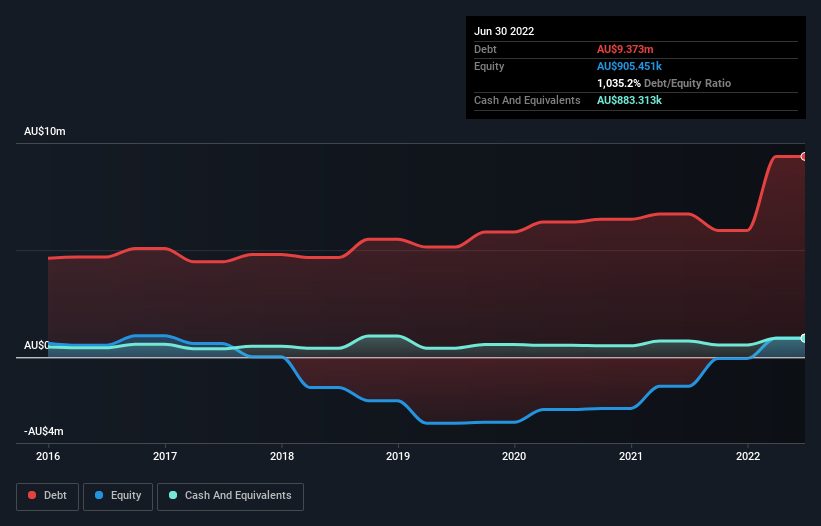
Some say volatility, rather than debt, is the best way to think about risk as an investor, but Warren Buffett famously said that 'Volatility is far from synonymous with risk.' So it might be obvious that you need to consider debt, when you think about how risky any given stock is, because too much debt can sink a company. Importantly, Inventis Limited (ASX:IVT) does carry debt. But should shareholders be worried about its use of debt?
Why Does Debt Bring Risk?
Debt assists a business until the business has trouble paying it off, either with new capital or with free cash flow. Part and parcel of capitalism is the process of 'creative destruction' where failed businesses are mercilessly liquidated by their bankers. However, a more frequent (but still costly) occurrence is where a company must issue shares at bargain-basement prices, permanently diluting shareholders, just to shore up its balance sheet. Of course, the upside of debt is that it often represents cheap capital, especially when it replaces dilution in a company with the ability to reinvest at high rates of return. The first step when considering a company's debt levels is to consider its cash and debt together.
See our latest analysis for Inventis
What Is Inventis's Debt?
As you can see below, at the end of June 2022, Inventis had AU$9.37m of debt, up from AU$6.69m a year ago. Click the image for more detail. However, it also had AU$883.3k in cash, and so its net debt is AU$8.49m.

How Strong Is Inventis' Balance Sheet?
According to the last reported balance sheet, Inventis had liabilities of AU$7.07m due within 12 months, and liabilities of AU$9.46m due beyond 12 months. Offsetting these obligations, it had cash of AU$883.3k as well as receivables valued at AU$3.07m due within 12 months. So it has liabilities totalling AU$12.6m more than its cash and near-term receivables, combined.
This deficit casts a shadow over the AU$5.53m company, like a colossus towering over mere mortals. So we'd watch its balance sheet closely, without a doubt. After all, Inventis would likely require a major re-capitalisation if it had to pay its creditors today. The balance sheet is clearly the area to focus on when you are analysing debt. But it is Inventis's earnings that will influence how the balance sheet holds up in the future. So when considering debt, it's definitely worth looking at the earnings trend. Click here for an interactive snapshot.
Over 12 months, Inventis reported revenue of AU$12m, which is a gain of 9.4%, although it did not report any earnings before interest and tax. That rate of growth is a bit slow for our taste, but it takes all types to make a world.
Caveat Emptor
Over the last twelve months Inventis produced an earnings before interest and tax (EBIT) loss. To be specific the EBIT loss came in at AU$54k. Considering that alongside the liabilities mentioned above make us nervous about the company. It would need to improve its operations quickly for us to be interested in it. Not least because it burned through AU$135k in negative free cash flow over the last year. So suffice it to say we consider the stock to be risky. The balance sheet is clearly the area to focus on when you are analysing debt. However, not all investment risk resides within the balance sheet - far from it. For example Inventis has 4 warning signs (and 3 which are significant) we think you should know about.
If you're interested in investing in businesses that can grow profits without the burden of debt, then check out this free list of growing businesses that have net cash on the balance sheet.
New: AI Stock Screener & Alerts
Our new AI Stock Screener scans the market every day to uncover opportunities.
• Dividend Powerhouses (3%+ Yield)
• Undervalued Small Caps with Insider Buying
• High growth Tech and AI Companies
Or build your own from over 50 metrics.
Have feedback on this article? Concerned about the content? Get in touch with us directly. Alternatively, email editorial-team (at) simplywallst.com.
This article by Simply Wall St is general in nature. We provide commentary based on historical data and analyst forecasts only using an unbiased methodology and our articles are not intended to be financial advice. It does not constitute a recommendation to buy or sell any stock, and does not take account of your objectives, or your financial situation. We aim to bring you long-term focused analysis driven by fundamental data. Note that our analysis may not factor in the latest price-sensitive company announcements or qualitative material. Simply Wall St has no position in any stocks mentioned.
About ASX:IVT
Inventis
Designs, manufactures, markets, and sells ergonomic office furniture, electronic control systems, and computing products in Australia.
Moderate and slightly overvalued.
Market Insights
Community Narratives




